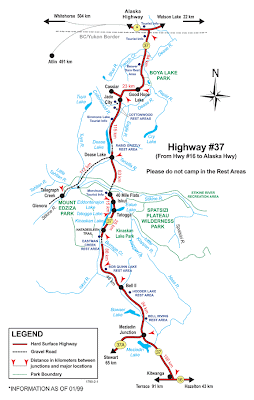
Northwest BC has a chance to have a huge amount of development along the Highway 37 corridor.
There are two mines already in operation in the area - Barrick Gold's Eskay Creek and Cusac Gold Mines Table Mountain mine which is open after 7 years being closed. Eskay produced 3500 kg of gold in 2006 and 170 000 kg silver - a value of about $150 000 000. Cusac is expected to produce abotu 750 kg of gold for a value of close to $15 000 000.
Mines that could operate in the area:
- Red Chris
- Schaft Creek
- Galore Creek
- Mount Klappan
- Kutcho Creek
- There are somewhere over a dozen significant exploration projects in the region
The highway 37 corridor also has a lot of timber and has seen relatively low harvesting. If one were to make access better along the highway and one were to provide cheaper power via the grid, the areas that are economical will increase. The current AAC of the Cassiar TSA is 400 000 cubic meters a year. This assumes that 50% of the forested land is uneconomical at this time.
With a mill in the region, the operable areas will increase dramatically in my opinion. Right now the Timber Harvesting Land Base is considered to be a bit less than 200 000 hectares. At the moment the timber has to be trucked a long distance to get any market. If you put a mill in the region - say one at Lower Post and one at Dease Lake, the THLB will rise dramatically. It costs about $2/hour to transport a tonne of material. A loaded truck can carry about 40 tonnes of logs or 40 000 board feet of lumber. 40 tonnes of sawlogs is a value of $2500 to $4000. The lumber is worth about $14 000.
Dease Lake to Prince Rupert is 785 km - Dease Lake to Stewart is 400 km. The first is a 20 to 24 hour round trip - a trucking cost of about $2000 and the second is a 12 hour round trip and a trucking cost of about $1000. You can see that with these prices, moving raw logs is simply only worth it if the timber has a very low cost of harvesting and high value. But moving lumber it becomes a lot more economical. The trucking the ports is not a huge portion of the costs.
One big mill in Dease Lake could produce 400 000 000 board feet of lumber from an AAC of about 1 000 000 cubic meters of timber. The value of this mill would be $120 000 000 in new lumber sales per year. The province would see an additional $20 000 000 a year in stumpage alone. But such a mill needs good electrical power and access to good transportation.
If you bring rail into and through the region, you really open up a whole set of bulk materials for the market as well. Coal, pulp and paper, industrial minerals and more.
With a better highway, a grid and rail to Yukon and Alaska, you improve the economics for everyone.
What I believe is needed is
- A full transmission line all the way through to Alaska.
- A first rate fully paved road to the Yukon border.
- A plan to upgrade the port facilities at Stewart for bulk materials.
- A rail line as was planned by BC rail many years ago to go through to the Yukon
- A rail spur from the existing line where the Sustut enters the Skeena to Stewart - a distance of about 200 km
- Construction of the Stewart Omineca resource road, though I would build it as a full highway which would run from Mackenzie/McLeod Lake via the Kemess mine location to Stewart.

No comments:
Post a Comment